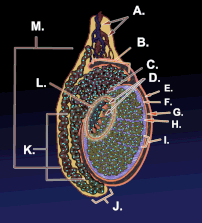
From ScienceDaily:
In almost all adult mammals, testes are located either in a scrotum or in the lower abdomen. But testes initially develop deep inside the abdomen at a position close to the kidneys, as seen in mammalian embryos. The final testicular position is the result of a descent process that occurs during animal development. However, several African species such as elephants, tenrecs, golden moles, elephant shrews, manatees, and rock hyraxes differ from the other mammals by lacking any descent and having testes at their initial abdominal position. It is an open question whether these African species lost the testicular descent process or whether other mammals gained that feature. Thomas Lehmann from the Senckenberg Frankfurt adds: “The evolution of testicular descent is controversial, because it is not fully understood how the African species are related to other mammals.”
“To resolve this controversy, we analyzed DNA sequence data of 71 mammals and discovered that these African mammals possess non-functional remnants of two genes that are strictly required for testicular descent in other mammals” explains Virag Sharma, the first author of the study. This shows that functional versions of these genes were once present in the ancestors of African mammals that lack testicular descent today. These “molecular vestiges” suggest that the testicular descent process took place in the ancestor and was subsequently lost in African mammals.
“Importantly, this conclusion holds regardless of ongoing controversies about the evolutionary relationships among mammals” explains Heiko Stuckas from the Senckenberg Dresden. “The increasing availability of DNA sequence data of many species provides unprecedented opportunities to hunt for molecular vestiges and thus resolve debates on evolution of other anatomical traits” concludes Michael Hiller, who supervised the study. Paper. (open access) – Virag Sharma, Thomas Lehmann, Heiko Stuckas, Liane Funke, Michael Hiller. Loss of RXFP2 and INSL3 genes in Afrotheria shows that testicular descent is the ancestral condition in placental mammals. PLOS Biology, 2018; 16 (6): e2005293 DOI: 10.1371/journal.pbio.2005293 More.
Note: Some Darwinian just-stories from Wikipedia:
The basal condition for mammals is to have internal testes.[25] The testes of the non-boreotherian mammals, such as the monotremes, armadillos, sloths, and elephants, remain within the abdomen.[not in citation given][26] There are also some marsupials with external testes[27] and Boreoeutherian mammals with internal testes, such as the rhinoceros.[28] Cetaceans such as whales and dolphins also have internal testes.[29] As external testes would increase drag in the water they have internal testes which are kept cool by special circulatory systems that cool the arterial blood going to the testes by placing the arteries near veins bringing cooled venous blood from the skin.[30][31]
See how genome mapping can wreck a perfectly good Darwinian just-so story? It turn out that external testes were in fact the “basal condition.”
A friend writes to say that this sounds like purifying selection on those mammal species whose
males have testicles outside their bodies. But, he adds, “Just a minute! External testicles are a useless, poorly designed feature, according to ID critics… “
 Yeah. Nathan Lents call your office. Some people want to ask you about your book,Human Errors: A Panorama of Our Glitches, from Pointless Bones to Broken Genes.
Yeah. Nathan Lents call your office. Some people want to ask you about your book,Human Errors: A Panorama of Our Glitches, from Pointless Bones to Broken Genes.
See also: A systems architect looks at claims about the “botched” human body
Anatomist: The perfect human body would have legs like an ostrich
Does Nathan Lents, author of a “bad design” book really teach biology? A doctor looks at his claims about the human sinuses
At Skeptic: Five Questions from biology prof Nathan Lents about Human Errors for Proponents of Intelligent Design
External testicles another instance of bad design? Oddly, in making such a dramatic claim (“there is no good reason that sperm development has to work best at lower temperatures”), Lents does not quote any expert on the subject of temperature and sperm development.
and
Jonathan Wells on Lents’s claim that the human eye is wired backwards